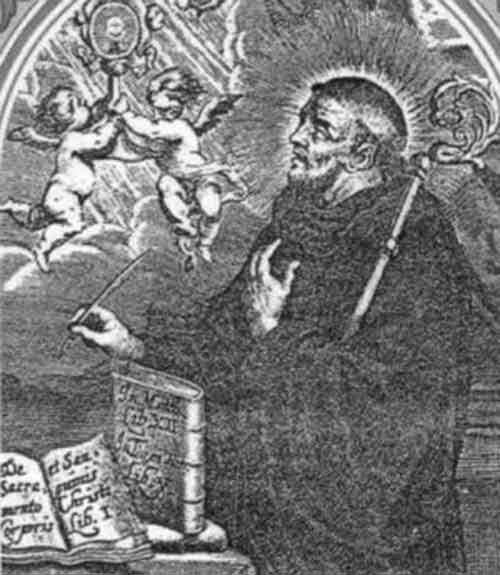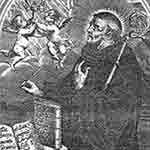
Paschasius Radbertus (785–865) wrote De corpore et sanguine Christi (“Concerning Christ’s Body and Blood”). As, on Sundays, for five weeks we are reflecting on John 6, this is a good time to re-look at the Eucharist.
This post can be regarded as the third in a series.
Read this first.
Read this second.
Radbertus started what is called the First Eucharistic Controversy. He wrote De corpore et sanguine Christi (“Concerning Christ’s Body and Blood”) in which he taught a complete identity between the historical body of Christ, born of Mary, and the Eucharistic body of Christ. This real body of Christ is eaten mystically and not in away that is perceptible to the senses. He uses the miraculous multiplication of the loaves as a model for the miraculous multiplication of Christ’s flesh in the wafers. Radbertus also taught that in the Eucharist Christ suffers and dies again. Those who disagreed with Radbertus distinguished the historical body of Christ, the church as the body of Christ, and the Eucharistic body of Christ. These three are connected but not identical.
In response to reading the above book, the West Frankish king, Charles II (“the Bald”), asked Ratramnus (died c. 868) two questions: is Christ’s presence in the Eucharist only visible with the eyes of faith, or do our eyes actually see the body and blood of Christ? And is the body of Christ in the Eucharist the same as that “born of Mary, suffered, died and was buried and ascended to the heavens to the right hand of the father”?
Ratramnus’ response is also called De corpore et sanguine Christi. Christ, he teaches, is present “figuratively” – that is truly present not in a way visible to our natural eyes. Ratramnus taught that Christ’s Eucharistic presence is not the body born of Mary. That body, Ratramnus taught, is seated now at the right hand of the Father.
Ratramnus draws on Augustine’s categories of veritas and figura. Veritas is knowledge through bodily perception. In figura is knowledge through the symbolism of bodily perception. Following this distinction the veritas of the Eucharist is bread. The body of Christ is in the bread in figura. The body of Christ is seated at the right hand of the Father. For Ratramnus, it is not the physical, corporeal life that is communicated in the Eucharist. The life that it gives is spiritual.
In response, Radburtus continued in his position, adding (in a commentary on Matthew’s Gospel on the Words of Institution) that this is the flesh – not simply the power of the flesh, and the blood – not simply the power of the blood.
Please note, that this is set prior to the Recovery of Aristotle which began in the 12th Century. You noted the (neoplatonic) philosophical categories of Augustine. To “translate” this controversy into Aristotelian categories (ie. to make comments about transubstantiation) would be anachronistic.
To be continued…
If you appreciated this post, consider liking the liturgy facebook page, and/or signing up for a not-very-often email, …




I love these posts, though sometimes I will admit they are a bit too challenging for my lunch-time viewing. It makes me eager for the simplicity of office politics :O) Seriously though, you continue to teach me and I appreciate it.
I will admit that regarding the Presence, I fall in line with your comments from the second posting (“Transubstantiation”) :
“I contend that the Presence of Christ in the Eucharistic elements of consecrated bread and wine is a mystery beyond our comprehension. We seem to be able to live with mysteries – I cannot even explain how my phone works, but I know it does, and I am happy to use it. I have a similar approach to Christ’s Eucharistic Presence.”
Like you, the Presence is a mystery beyond my comprehension. And I am ok with that.
Thanks for your writings.
Stephen
Thanks for the encouragement, Stephen! Blessings.